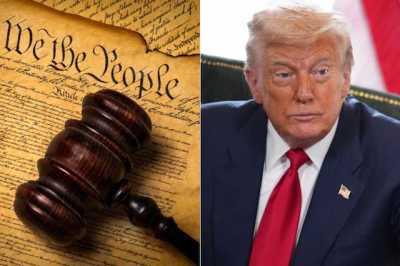Why Key Sections of the U.S. Constitution Disappeared from the Official Congress Website: It was done silently
Why Key Parts of the U.S. Constitution Disappeared from Congress.gov — and What It Really Means
In early August, many Americans were shocked to discover that key sections of the U.S. Constitution had quietly gone missing from the official Congress website — Congress.gov. Though the content has since been restored, the incident triggered a wave of speculation, concern, and political debate across social media and online forums.
What made this even more alarming to some was the specific content that had vanished — sections that outline the powers of Congress, the limits on those powers, and the powers denied to individual states. These aren’t obscure footnotes — they’re foundational components of American democracy.
⚖️ What Constitutional Sections Were Removed?
According to multiple outlets and forum users who archived screenshots, the Annotated Constitution on Congress.gov was missing the full texts of Section 8, Section 9, and Section 10 of Article I.
Here’s why that matters:
-
Article I, Section 8 defines the enumerated powers of Congress — such as the ability to levy taxes, declare war, regulate commerce, and establish a national currency.
-
Article I, Section 9 outlines restrictions on Congress, including a clause that protects civil liberties, such as the:
“Privilege of the Writ of Habeas Corpus shall not be suspended, unless when in Cases of Rebellion or Invasion the public Safety may require it.”
-
Article I, Section 10 places limits on state governments, forbidding them from entering into treaties, printing their own money, or raising armies during peacetime.
For many Americans — especially those familiar with history, law, or civil liberties — this disappearance wasn’t just a technical glitch; it struck at the heart of constitutional transparency and government accountability.
💥 Why the Writ of Habeas Corpus Clause Matters
Among the most-discussed omissions was the Writ of Habeas Corpus clause, which ensures that individuals cannot be held without just cause or due process.
This clause gained renewed attention in recent years, especially after White House Deputy Chief of Staff for Policy, Stephen Miller, stated in May that the Trump administration was “looking at” suspending the Writ of Habeas Corpus in relation to migrant detentions at the southern border, citing the constitutional exception for "invasion."
This context made the disappearance of Section 9 especially controversial — and gave fuel to conspiracy theories and government transparency watchdogs.
🔎 Online Reaction: Confusion, Outrage, and Speculation
The incident first gained traction on platforms like Reddit and Questionsforum.com, where users began noticing the missing text late Tuesday evening into Wednesday morning.
Some believed it was a technical accident, while others suspected deliberate action or censorship.
“They must think that removing those portions from their own site changes the Constitution,” wrote one user claiming to be in the military on Questionsforum.com.
“This isn’t a server problem — this is deliberate,” another Redditor posted.
Others suggested a more innocent cause:
“Somebody kicked a plug out of a Congress.gov server (edit: not literally, but somebody who was updating congress.gov messed up),” one comment read.
But with no immediate official explanation, the incident quickly went viral across digital platforms.
📣 The Library of Congress Responds
By late Wednesday morning, the Library of Congress, which manages the Constitution Annotated website, issued a public response on X (formerly Twitter):
“It has been brought to our attention that some sections of Article 1 are missing from the Constitution Annotated website. We’ve learned that this is due to a coding error. We have been working to correct this and expect it to be resolved soon.”
The message didn’t satisfy everyone. Critics argued that even if it was a coding error, the removal of such fundamental constitutional content should never have gone unnoticed internally.
However, as of the afternoon of the same day, all missing content was restored on Congress.gov.
🧩 Was It Really Just a Coding Error?
While the official explanation cites a technical or coding glitch, questions remain:
-
Why were only the sections about Congressional and state powers and limits affected?
-
How did a supposedly routine technical update result in the exact removal of entire constitutional sections?
-
Why wasn’t the issue caught before users spotted it?
The lack of detailed technical explanation has led some watchdog groups to call for a full audit of the website update process — and better fail-safes to prevent future incidents involving foundational government documents.
🧠 What This Teaches Us About Digital Governance
Whether you believe it was a simple mistake or something more, the event serves as a wake-up call about the fragility of digital access to vital information.
The U.S. Constitution is a public document. It should be preserved, accessible, and never subject to accidental deletion — especially on a government-hosted domain like Congress.gov.
As many users noted in the aftermath, it’s wise to:
-
Keep physical or downloadable PDF copies of important government documents
-
Use the Government Publishing Office (GPO) or National Archives as alternative reference points
-
Question and verify changes to public legal resources
📝 Conclusion: Transparency Is Non-Negotiable
Although the missing text from Congress.gov has been restored, the temporary removal of such critical constitutional sections has sparked important discussions about digital transparency, civil liberties, and government oversight.
Was it truly a coding error? Maybe. But in an era where public trust in institutions is low, even a minor digital mishap can raise major questions.
Let this serve as a reminder: The Constitution isn’t just a document — it’s a contract between the government and the governed. And that contract should never be hidden, even for a moment.
-
Missing Constitution text on Congress.gov
-
Article I Section 8, 9, 10 Congress website
-
Writ of Habeas Corpus removed
-
Library of Congress coding error
-
Constitution Annotated website issues
-
Habeas Corpus Trump administration
-
Why Constitution was removed from Congress site
-
U.S. Constitution website glitch

